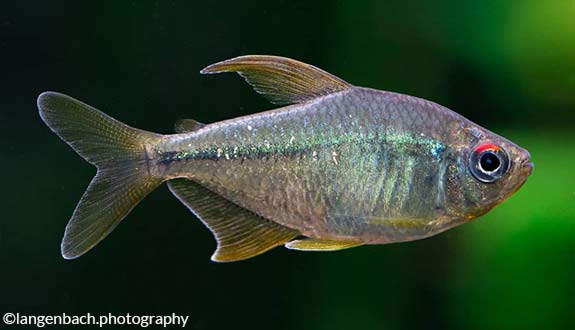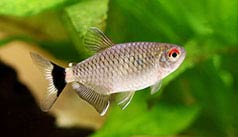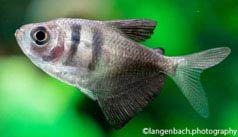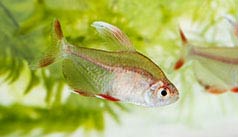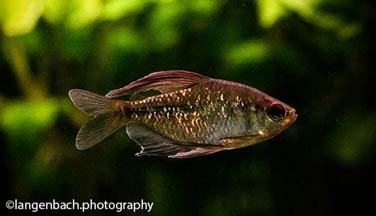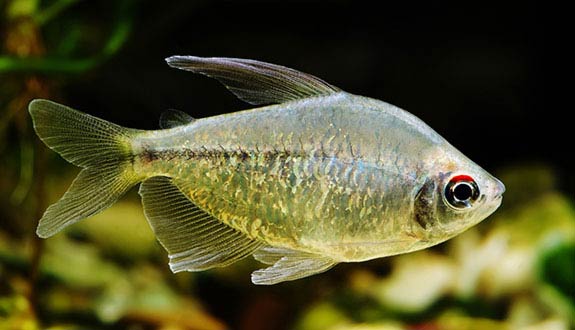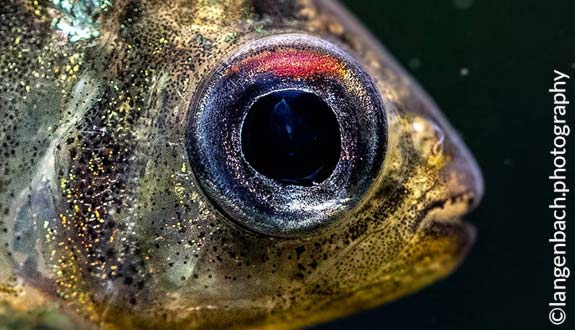

Alternative species (click on the thumbnail to see the card)
Names
Scientific name
Moenkhausia pittieri
Opisthanodus haerteli
Common name
Diamond tetra
Origin

Origin: Venezuela
Biotope: Amazonian
Dimorphism

The fins of the males are more developed, the dorsal is lengthened in sickle
Group

Characidae
Volume

100 L / 22 imp gal / 26 US gal
Parameters

T°: 24 à 27°C or 75 to 81°F
pH: 5.5 to 7
Hardness: 3 to 10°dGH
Difficulty

Average
Size

6 cm (2.4")
Longevity

5 years
Living zone
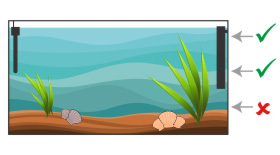
Middle and top
Individuals

8
Food
How to feed the Diamond tetra?
Food
How to feed the Diamond tetra?
Omnivorous, the Diamond Tetra accepts all forms of food.
Behavior
What kind of behavior does the Diamond tetra have?
Behavior
What kind of behavior does the Diamond tetra have?
Temperament quite lively and active. Each male defends its place by delimiting a small territory that it jealously defends by surprising parries of intimidation. Like all species of the genus, it possesses a gregarious instinct and must necessarily be kept in a shoal.
Cohabitation
Who can live with the Diamond tetra?
Cohabitation
Who can live with the Diamond tetra?
A community aquarium is accepted, but the Diamond Tetra can sometimes be slightly aggressive with other species (especially that the adult male can reach a good size). For example, cohabitation with long-finned fish is to be avoided. Indeed, if it is kept in too small numbers, the Diamond Tetra shows its aggressiveness on the wing species. This behavior will tend to fade into larger groups as the disputes remain internal to the species.
The ideal is to associate it with other Characidae. You can also combine large cichlids such as Discus and Geophagus, or ground-fish such as small Loricariidae.
Breeding
How to breed the Diamond tetra?
Breeding
How to breed the Diamond tetra?
As with many tetras, you can breed this species with some knowledge. Place in a spawning tank (20 L or 5 US Gallons or 4 Imperial Gallons) equipped with a protective grid and bushy plants, a male and a female. Temperature 24/26°C or 75/79°F, pH 6.5/7 and very low light. You can set up a filter on peat. Before introduction into the spawning tank, prepare spawning by separating the sexes and feeding the fish with live prey. The complete spawning can have up to 300 yellowish eggs and the incubation lasts 30 hours. Fry are fearful and grow slowly.
Fry food: infusoria, nauplies of artemia and cyclops.
Its aquarium
Which aquarium for the Diamond tetra?
Its aquarium
Which aquarium for the Diamond tetra?
It is relatively insensitive with its decor, although it will not be very comfortable in an aquarium too «naked». Indeed, this Tetra likes aquariums planted and decorated, but with space to swim freely.
You can favour a dark substrate, a peat filtration and a diffused light.
If you wish, you can opt for an Amazonian biotope tank. You will then use a river sand substrate, driftwood roots or twisted branches. Some dried leaves of oak or beech will strengthen the natural side (remember to renew these leaves before they rot). In general, the lighting of an Amazonian aquarium is relatively weak.
Good To know
Find all additional information!
Good To know
Find all additional information!
It will nibble gladly (but slightly) some tender young shoots of your plants. Think about choosing fairly robust plant species.
It is quite sensitive to variations in water parameters. Juvenile, it will appear dull and bland, while in good conditions, it will reveal all its splendour in adulthood, sparkling like a diamond:
Yours photos!
Comments
Sort by:
Please login to post comments
